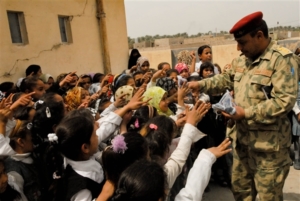4 Facts About Poverty in Iraq

About 22% of Iraqis live in poverty. Poverty in Iraq is a dynamic issue, the facets of which have changed with the country’s progress and efforts at modernization. Urbanization and the discovery of vast oil reserves have adversely impacted Iraqis with corruption and conflict driving poverty rates up. The following are four exceedingly relevant facts about poverty in Iraq and what the International Rescue Committee (IRC), a nongovernmental organization that emerged in 1933 to respond to international humanitarian crises, has done to help since entering Iraq in 2003.
4 Facts About Poverty in Iraq
-
Urbanization and Food Shortages: Recent conflict and economic change have caused Iraqis to concentrate in urban areas. Iraq is 70.7% urbanized and is nearly unrecognizable in comparison to its agricultural past. Poor agricultural policies have catalyzed this shift toward urbanization and overcrowding in cities. This, combined with military and economic crises, has resulted in as many as one in six households experiencing some form of food insecurity. Iraq has a universal food ration program called the Public Distribution System (PDS), which is its most extensive social assistance program, but it has not been enough. Many Iraqis who have either lost access to the PDS or find that it does not cover enough, have turned to humanitarian agencies like the IRC for aid. Since 2003, the IRC has helped hundreds of thousands of people: in 2018 alone, it assisted 95,000 Iraqis, providing financial, familial, educational and professional support.
-
Corruption and Oil: According to Transparency International, Iraq is the 13th most corrupt country. The Iraqi government often subsidizes inefficient state industries, which has led many Iraqis to view government and business leaders as corrupt. With the rise in oil prices over the past decades, Iraq’s government had sufficient funds to complete significant reconstruction and aid projects. However, poverty in Iraq has not improved. The oil sector provides an estimated 85% to 95% of government revenue. High-level corruption in Iraq impedes the development of private, non-oil business sectors, spurring overdependence on oil. Protests were rampant in 2019 with Iraqis indignant that their economy was flush with oil money but their government was too corrupt to provide basic services. Average Iraqi citizens never see oil profits due to the corrupt nature of the Iraqi government, which empowers politicians through informal agreements and patronage. Leaders hand out government jobs to build their support networks and stifle dissent, making the public sector inefficient and draining oil profits such that there is little left over for investment in social programs. While federal social programs are lacking and corruption is still serious, NGOs like the IRC have stepped in to pick up the slack and somewhat lighten the suffering of many Iraqis.
-
Poverty and Unemployment: Roughly 95% of young Iraqis believe they need strong connections to those in power in order to obtain employment. Overall, unemployment is at 11% with one-third of Iraqi youths unemployed and 22% of the population living in poverty. The aforementioned protests in 2019 involved young Iraqis frustrated at being unable to find work, and projections determine that unemployment and poverty will worsen even further in 2020. The United Nations expects the poverty rate to double to around 40%, with monthly oil revenues falling from $6 to 1.4 billion between February and April 2020 due to the recent collapse in global oil prices. To combat these figures, the International Rescue Committee (IRC) has provided more than 40,000 people with emergency supplies, business training and funding to help Iraqis rebuild their lives.
-
War and Internal Displacement: Conflict with ISIS led to the displacement of more than 6 million Iraqis from 2014 to 2017, and about 1.5 million Iraqis remain in camps despite the recent territorial defeat of the terrorist organization. The rise and conquest of ISIS was a primary driver behind the increase of the poverty rate to the current level of 22%, with forced displacement and brutal violence leading to the destruction of Iraqi homes, assets and livelihoods. The above factors have struck internally displaced persons (IDPs) the hardest — few IDPs have employment and most have to support an average of six other members in their household. On top of all this is the fact that many IDPs have lost access to what little the PDS food program does supply, illustrating the true humanitarian challenge of poverty in Iraq. While the displacement and refugee issue is still serious today, the International Rescue Committee has aided over 20,900 women and girls to recover from the violence, providing hope for a battered people.
Looking Ahead
Despite expansive oil profits flooding into the Iraqi system, this money does not reach ordinary Iraqis who struggle to provide for their families. The failure of urbanization, stark unemployment and violent conflict with ISIS have exacerbated the lack of action from corrupt business and political leaders to address the systemic issue of poverty.
Experts expect global poverty to worsen during the current COVID-19 pandemic, especially in Iraq. Combined with the recent crash in oil prices, this will likely lead to serious unrest in a country that has struggled for decades to bring about some semblance of effective governance. Despite the ongoing issues that these four facts about poverty in Iraq show, hope continues to live on thanks to organizations like the IRC that are able to provide aid.
Photo: U.S. Department of Defense
